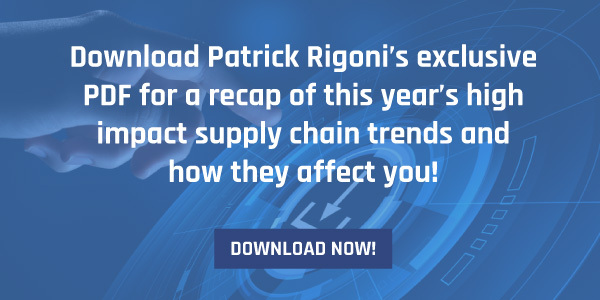The supply chain has been under the spotlight over the last year, as consumers and corporations have experienced firsthand the domino effect of weak and missing links. The global pandemic ushered in an era of ricocheting supply and demand. Now, companies pulling themselves out of the wreckage want to safeguard themselves against future threats. The current climate is full of opportunities for savvy supply chain managers.
It was no surprise, then, that “Positioning supply chain as the driving force in your business” was the first theme in the lineup at the 2021 Reuters Supply Chain Europe virtual conference. Speakers dished on topics like reducing fragility across the supply chain, the crucial importance of data, and earning a seat at the stakeholder table.
What can we learn from industry experts about placing supply chain management high on the corporate priority list? We’re breaking down some key strategies to help you do just that while upholding the principles of Patrick Rigoni’s highly successful Demand Driven approach.
Define Supply Chain Planning
It sounds deceptively simple. Reality is, it’s crucial. Make sure everyone in your organization is on the same page about what supply chain planning (SCP) is and isn’t. The first step in positioning supply chain management as the driving force in your business is education.
Stakeholders should possess an understanding of the various dimensions involved in SCP: the product, warehouse & plant, and time dimension. They should be clear how each node within a network interacts with the others. Most importantly, all parties should recognize the value supply chain managers bring to the organization by offering a bird’s eye view of the entire chain, while remaining acutely aware of the details within each dimension.
Not sure where to get started? We’ve got you covered with a primer that explains the basics of SCP. Share your knowledge with key decision makers so they can recognize where supply chain management fits into the organizational agenda.
Eliminate Fragility
To push the supply chain to the front of the agenda, minimizing complexity and increasing flexibility across the business is a must. This was heavily discussed during the first Fireside Chat at this year’s Reuters conference, where Sami Naffakh, CSCO and Member of the Group Executive Committee at Reckitt, moderated a virtual conversation on the topic.

Building resilience into the fabric of your supply chain plan is mandatory. As demands within the business shift, staying a few steps ahead of the next curveball places the supply chain in a strong position to build organizational confidence.
Diversification, redundancy, and cultural transformation all contribute towards resilience. If you need a refresher on banishing weak spots within the supply chain, consider reviewing Patrick Rigoni’s guide on building resilience.
Bottom line: a rock solid supply chain makes for a rock solid business.
Make Friends with Data
With ever-more sophisticated data collection, management, and visualization tools, it’s never been easier to demonstrate the value of supply chain planning.
Data can support supply chain managers in keeping on target with the company’s tactical goals. It can also support alignment of supply chain objectives with larger business-wide goals. Digital data applications are key for organizational transparency and shared decision-making.
Cloud computing and data visualization can fortify the supply chain, making it resistant to disruption and driving forward the business as a whole.
Align with Corporate Strategy
It’s crucial to get that seat at the stakeholder table so that organizational goals and supply chain plans can line up side-by-side. Aligning with strategic goals across the business empowers digital transformation and ensures customer needs are always front and center.
We recommend a multi-pronged approach:
Set supply chain performance metrics that mesh well with corporate strategy. This isn’t a one-size-fits-all dynamic, but should involve dialogue with management to construct a system that aligns with goals across the organization.

Consider the business’ strategic goals when designing the supply chain. Flexibility, responsiveness, and cost-efficiency matter, but not necessarily in that order. Ensure your priorities match up with those of your organization. This will boost the supply chain as a driving force in effecting change across every level.
Supply chain managers deserve a seat at the head of the table. Make sure you earn your place by staying on top of this year’s supply chain management trends.
We’ve compiled a guide to the top 10 supply chain trends of 2021, available as an exclusive premium resource from Patrick Rigoni. Download yours today to ensure supply chain management remains the cornerstone of your organization!







